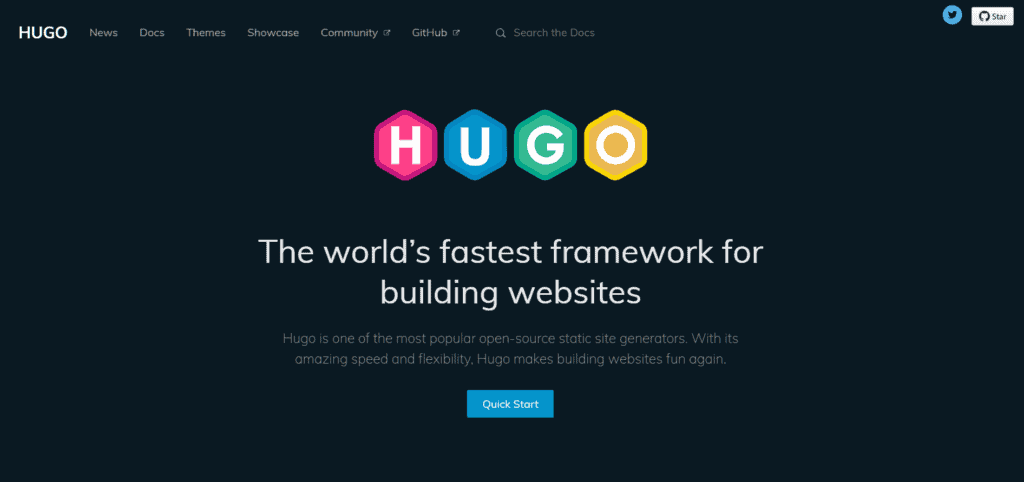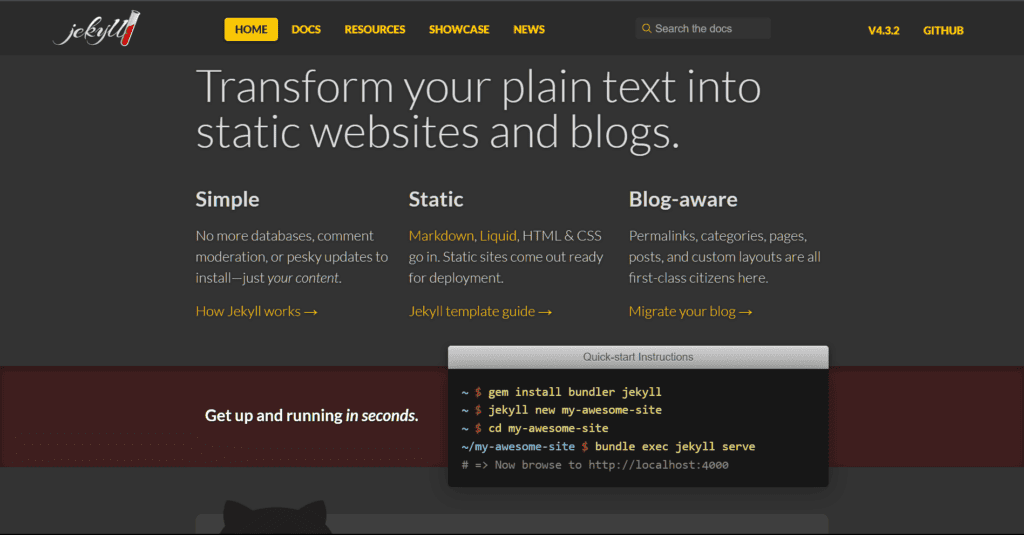Are you tired of slow-loading websites and worried about the security of your online platform? Look no further – it’s time to explore the world of static site generators!
TL;DR: A slow website can significantly turn off your visitors and potential customers in today’s fast-paced digital age. Not only does it affect user experience, but it also hampers your search engine rankings. However, there is a solution that can revolutionize your website’s speed and security – static site generators.
- What is a static site generator?
- What are the pros and cons of using a static site generator?
- Static site generator vs. traditional content management systems
- Popular static site generators
- How to use a static site generator from scratch?
- How to choose the right static site generator for your website
- Enhancing website security with a static site generator
These powerful tools allow you to create lightning-fast, secure, and highly efficient websites that impress your audience and boost your online presence. This article will dive into the benefits of using a static site generator, how it works, and why it’s an essential tool for any website owner or developer. Get ready to take your website to new heights with the speed and security that a static site generator brings!
What is a static site generator?
A static site generator is a powerful tool for building fast, secure, and highly efficient websites by pre-generating static HTML files. By separating content and presentation, static site generators provide greater flexibility and control over the design and structure of your website. Additionally, the inherent security benefits make static site generators an excellent choice for websites that prioritize data protection.
What are the pros and cons of using a static site generator?
The following advantages are some reasons why other website owners prefer using a static site generator:
Creates lightning-fast page load times
A static site generator is a tool that helps you build websites with static HTML files as output. Unlike traditional content management systems (CMS) that dynamically generate web pages on the server, static site generators pre-generate the entire website as a collection of HTML, CSS, and JavaScript files. This means that when users visit your website, they are served with pre-rendered static files, resulting in lightning-fast page load times. Static site generators are top-rated for websites with primarily static content, such as blogs, portfolios, documentation sites, and landing pages.
Separates content and presentation
One of the key advantages of using a static site generator is the separation of content and presentation. The content and presentation are tightly coupled with traditional CMS platforms, making changing the website’s design or structure easier without affecting the content. However, with a static site generator, you can easily update the design and layout of your website without touching the content, providing greater flexibility and control over your site’s overall look and feel.
Customizable
CMS website formats are limited by the built-in templates and fields you can enter. If you want more flexibility, you will need to use plugins or overwrite the codes. However, when you use a static site generator, you can freely design and build your website. You can write your own HTML and text in any format you want.
Improves Security
Static site generators also offer improved security compared to traditional CMS platforms. Since static sites don’t rely on server-side scripting or databases, they are less vulnerable to hacking attempts and security breaches. A static site generator eliminates many security risks associated with dynamic websites, such as SQL injection, cross-site scripting (XSS), and server vulnerabilities. This makes static site generators an excellent choice for websites prioritizing security and data protection.
Static site generator vs. traditional content management systems
Building websites has two main approaches: a static site generator or a traditional content management system (CMS). While both methods have pros and cons, understanding their differences can help you decide based on your needs and requirements.
Traditional CMS platforms like WordPress, Drupal, and Joomla are widely used for building dynamic websites. These CMS platforms provide a user-friendly interface for managing content, allowing website owners and administrators to create, edit, and publish web pages without knowledge of HTML, CSS, or other programming languages. The dynamic nature of CMS platforms enables features like user authentication, commenting systems, e-commerce functionality, and more.
However, this flexibility and dynamic nature come at a cost. Dynamic websites rely on server-side scripting and databases to generate web pages on the fly. Whenever a user accesses a page, the server must process the request, retrieve the necessary content from the database, and dynamically generate the HTML. This process can be resource-intensive and result in slower page load times, especially for websites with high traffic or complex functionality.
On the other hand, static site generators take a different approach. As mentioned earlier, static site generators pre-generate the entire website as a collection of static HTML files. This means the server only needs to serve the pre-rendered static files, resulting in faster page load times and improved performance. Static site generators are particularly well-suited for websites with primarily static content, such as blogs, portfolios, and documentation sites.
Another significant difference between static site generators and traditional CMS platforms is the technical expertise required. CMS platforms are designed to be user-friendly and accessible to individuals without programming knowledge. However, customizing the design or functionality of a CMS-based website often requires coding skills or using plugins and themes. In contrast, static site generators typically require technical knowledge, as they often involve working with a command-line interface and writing code in languages like Markdown, HTML, CSS, and JavaScript. Although this may initially seem intimidating, it provides greater flexibility and control over the website’s structure and performance.
Choosing between a static site generator and a traditional CMS depends on your needs and requirements. If you prioritize speed, security, and simplicity for a primarily static website, a static site generator may be the ideal choice. On the other hand, if you require dynamic functionality, user authentication, or e-commerce features, a traditional CMS platform better suits your needs. Consider your website’s purpose, content, and technical expertise before deciding.
WordPress site vs. static HTML site
With WordPress or another CMS generated-website, you simply publish your content, upload your files, and host media on the front end. You do not need to touch any of the codes in the back end. This means you can create and manage your website even if you don’t know how to code. With CMS, you can also use templates and plugins to customize your website’s functionality and design.
With a static site, you use a coding language to create HTML (Hypertext Markup Language) web pages from scratch. You write a program together with your content and put it on your server. It is sometimes called a flat or stationary page because the page displayed in the web browser is exactly as it is stored on the server. It stays the same for every page visitor.
Popular static site generators
Now that you understand the benefits of using a static site generator and how it differs from traditional CMS platforms, let’s explore some popular static site generators available today. Each static site generator has its own features, advantages, and community support, so choosing one that aligns with your specific needs and preferences is essential. Here are a few of the most popular options:
1. Gatsby

Gatsby is a modern static site generator built on React.js. It combines the power of static site generation with a dynamic, component-based UI framework. Gatsby’s plugin ecosystem allows you to extend its functionality and integrate with various data sources, making it suitable for complex websites and applications. Additionally, Gatsby provides excellent performance optimizations, such as code splitting and lazy loading, resulting in lightning-fast websites.
2. Hugo

Hugo is a fast and flexible static site generator written in Go. It boasts incredible speed and is known for its blazing-fast build times, making it an excellent choice for large websites. Hugo supports multiple content formats, including Markdown, HTML, and even CSV, making it highly versatile. It also provides a wide range of themes and templates, allowing you to easily create visually stunning websites.
3. Jekyll

Jekyll is one of the most widely used static site generators. It’s a Ruby-based tool that allows you to build simple, blog-aware websites. Jekyll uses Markdown for content creation and provides a flexible templating system, making it easy to customize the design and layout of your site. It also integrates well with version control systems like Git, making it a popular choice for developers.
4. Next.js

While Next.js is primarily known as a framework for building server-rendered React applications, it also offers static site generation capabilities. Next.js allows you to generate static HTML files at build-time or dynamically fetch data at runtime, providing a hybrid approach between static and dynamic websites. With features like automatic code splitting, server-side rendering, and incremental static regeneration, Next.js offers excellent performance and flexibility.
These are just a few examples of the many static site generators available. Each tool has strengths and weaknesses, so evaluating your requirements and exploring the documentation and community support for each option is essential. Whether you prioritize simplicity, performance, or a specific programming language, there is likely a static site generator that fits your needs.
How to use a static site generator from scratch?
Now that you understand what static site generators are and the popular options available let’s delve into how to use a static site generator from scratch.
Specific steps may vary depending on your chosen static site generator, please check out its documentation for the installation. Below though can give you an overview of what to expect when installing a static site generator:
1. Choose a static site generator
Evaluate your requirements and preferences to select the most suitable one for your project. Consider factors like programming language familiarity, community support, and available plugins or themes.
2. Install the static site generator
Follow the installation instructions provided by the static site generator’s documentation. This typically involves installing necessary dependencies, such as programming language runtimes or package managers.
3. Create a new site
Use the static site generator’s command-line interface (CLI) to create a new website project. This will generate a basic directory structure and configuration files to get you started.
4. Configure your site
Customize your website’s configuration files to define settings such as site titles, navigation menus, default layouts, and additional plugins or themes. Refer to the static site generator’s documentation for specific configuration options.
5. Create content
Use Markdown or other supported formats to create your website’s content. Organize your content into directories and files based on your desired structure. Take advantage of features like front matter or metadata to add additional information to your content, such as titles, dates, or categories.
6. Design your site
Customize the design and layout of your site by modifying the provided templates or creating your own. Depending on the static site generator, you may need to learn the specific templating language or use HTML and CSS directly.
7. Build your site
Use the static site generator’s build command to generate the static HTML files for your website. This process will compile your content, apply the defined templates, and develop the necessary assets, such as CSS and JavaScript files.
8. Preview and test
Use a local development server provided by the static site generator to preview your website and test its functionality. This allows you to identify issues, such as broken links or formatting errors, before deploying your site.
9. Deploy your site
Once you are satisfied with your website’s preview, it’s time to deploy it to a hosting provider or a content delivery network (CDN). Follow the deployment instructions provided by the static site generator and configure any necessary settings, such as custom domains or SSL certificates.
10. Update and maintain
Regularly update your website’s content, design, and configuration. Monitor your site’s performance and security, and apply any updates or optimizations the static site generator provides.
Remember to refer to your chosen tool’s specific documentation and community resources, as the details may vary. With practice and experimentation, you’ll become proficient in using static site generators and unlock their full potential.
How to choose the right static site generator for your website
With the abundance of static site generators available, choosing the right one for your website can be a daunting task. To help you make an informed decision, consider the following factors when evaluating static site generators:
1. Project requirements
Start by understanding your project’s specific requirements. Consider factors such as the type of website you want to build (blog, portfolio, e-commerce, etc.), the desired level of customization, the need for dynamic functionality, and any specific programming language preferences.
2. Ease of use
Evaluate the ease of use of each static site generator. Consider the learning curve, the availability of comprehensive documentation, and the presence of an active and supportive community. A user-friendly static site generator will make the development process more enjoyable and efficient.
3. Performance
Performance is a critical factor for any website. Look for static site generators that offer performance optimizations, such as code splitting, lazy loading, and image optimization. Additionally, consider the build times of the static site generator, as faster build times can significantly improve your development workflow.
4. Flexibility and extensibility
Consider the flexibility and extensibility of each static site generator. Look for options that provide various plugins, themes, and templates. This will allow you to customize your website’s design and functionality to suit your needs without reinventing the wheel.
5. Community support
Evaluate the size and activity of the community surrounding each static site generator. A vibrant community ensures ongoing development, maintenance, and support for the tool. It also means a larger pool of resources, tutorials, and plugins to draw from.
6. Integration with other tools
Consider the integration capabilities of each static site generator. Look for options that seamlessly integrate with other devices you use, such as version control systems (Git), content management systems (CMS), or deployment platforms. This will streamline your development workflow and enhance productivity.
7. Long-term viability
Consider the long-term viability of each static site generator. Look for tools with a strong development roadmap, regular updates, and a history of stability. Choosing a tool with long-term support ensures you can use an updated or abandoned solution.
By carefully considering these factors, you can narrow your options and choose the right static site generator for your website. Remember that there is no one-size-fits-all solution, and what works for one project may not work for another. Take the time to experiment, try out different static site generators, and evaluate how well they meet your specific needs.
Enhancing website security with a static site generator
Website security is of paramount importance. With the increasing number of cyber threats and security breaches, it’s crucial to take proactive measures to protect your website and the sensitive data it may contain. Fortunately, using a static site generator can enhance your website’s security in several ways.
Let’s explore some of the security benefits of using a static site generator:
1. Reduced attack surface
Static sites have more minor attacks than dynamic websites. Since static site generators pre-generate the entire website as static HTML files, there is no need for server-side scripting or databases. This eliminates many common security vulnerabilities associated with dynamic websites, such as SQL injection, cross-site scripting (XSS), and server misconfigurations.
2. No server-side vulnerabilities
Static site generators eliminate the risk of server-side vulnerabilities. With traditional CMS platforms, server vulnerabilities can expose your website to attacks and compromises. However, since static site generators generate static files that can be served by any web server, the attack vectors are significantly reduced.
3. No database vulnerabilities
Dynamic websites that rely on databases are often vulnerable. These vulnerabilities can result in unauthorized access, data breaches, or data manipulation.
What is our preference?
We love Gatsby simply because it is what we’ve tested thoroughly in the past with a couple of websites when Gatsby first started out.

